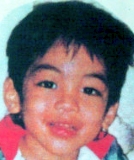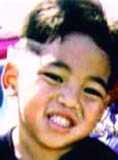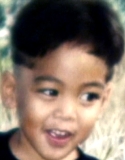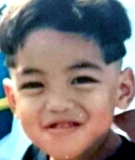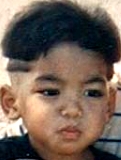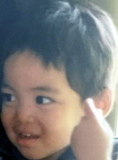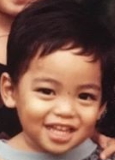Peter J. Kema Jr.
Peter, circa 1997; Age-progression to age 19 (circa 2010); Sketch of Auntie Rose Makuakane, circa 1997; Peter Kema Sr., circa 1991; Peter Sr. in 2004; Peter Sr. in 2015; Jaylin Kema, circa 1992; Jaylin in 2005; Jaylin in 2015
- Missing Since 09/11/1997
- Missing From Honolulu, Hawaii
- Classification Endangered Missing
- Sex Male
- Race Asian, Biracial, Native American, Pacific Islander, White
- Date of Birth 05/01/1991 (34)
- Age 6 years old
- Height and Weight 4'0, 50 pounds
- Medical Conditions Peter has a history of bronchitis and upper respiratory infections.
- Distinguishing Characteristics Multiracial male. Black hair, brown eyes. Peter is of Filipino, Spanish, Chinese and Native Hawaiian descent. His nicknames are Pepe and Peter Boy.
Details of Disappearance
Peter Jr.'s mother, Jaylin Maureen Acol Kema, told authorities she last saw her son sometime during August 1997. His father, Peter Kema Sr., claimed that he brought the child with him when he traveled to Honolulu, Hawaii to search for employment that month.
Photographs of Jaylin and Peter Sr. are posted with this case summary. Peter Sr. claimed that he and his son were homeless and lived in a tent in A'ala Park with eighteen other people during the time. He stated he never completed any job applications, as area businesses were not hiring new workers.
Peter Sr. allegedly gave his son to a family friend named "Auntie" Rose Makuakane on August 19, 1997 in A'ala Park. A sketch of Makuakane is posted with this case summary. Peter Sr. claimed that he and his wife could no longer provide for Peter Jr. and Makuakane, who did not have children, was better able to care for their son. He said he stayed with them for several days to make sure they were getting along.
He said Makuakane was a lauhala weaver and frequently sold hats in the park during the weekend for $5 each. He also claimed she was a cousin from his stepfather's family and a longtime friend, although he had not seen her since 1982.
Peter Sr. produced a copy of a letter which he said he had written to Makuakane, stating he was surrendering his parental rights and was giving Makuakane custody of Peter Jr. The letter was dated September 11, 1997 rather than August 19, the date Peter Sr. had claimed he last saw his son. He had no explanation for the discrepancy.
Peter Sr. provided authorities with a physical description of Makuakane. He claimed that she was approximately 47 years old in 1997. She was 5'0 to 5'1 with a husky build, unbrushed curly salt-and-pepper hair and brown eyes. Peter Sr. said Makuakane is of Hawaiian, Japanese and Portuguese descent, with a fair complexion. He stated she normally wore floral-print shirts and shorts or pants with an elastic waist. He said she was planning to move to a beach community in Florida at the time that he gave her his son.
Although Peter Sr. claimed Makuakane was a longtime family friend, his relatives said that they never heard of her prior to 1997. Authorities are not certain if she actually exists, as they were unable to locate anyone in A'ala Park who was familiar with her.
Makuakane was not registered with the Office of Hawaiian Affairs as a lauhala weaver, and when the police checked with all the Makuakanes listed in the Hawaiian telephone directories, they couldn't find anyone who had heard of her. Peter Jr.'s parents admitted that they did not have any contact information for Makuakane. Investigators said his parents didn't appear to be interested in locating him.
Hawaii has a history of unofficial adoptions referred to as "hanai." In the hanai tradition, the biological parents turn over custody of a child to a blood relative. The parents continue to have regular contact and visitations with the child afterwards and remain a central part of their child's life. Many people familiar with the customs of hanai have stated the Kema situation does not classify as such an arrangement, considering that Peter Jr.'s parents apparently never saw their son again.
Jaylin's parents, James and Yolanda Acol, occasionally cared for Peter Jr. since he was an infant; he was first removed from Peter Sr. and Jaylin's home in August 1991 due to multiple leg, hip and rib fractures, some of which were weeks old.
His parents claimed the fractures occurred when his two-year-old half-sister jumped on him, but the Hawaii Department of Human Services (DHS) found that the injuries were consistent with child abuse. One of the fractures to his leg was a spiral fracture, which can only be caused when the limb is twisted until it breaks.
Peter Jr.'s maternal grandparents wanted to retain custody of him, but the courts returned the child to his parents' care in 1995. James and Yolanda last saw him in 1996 and said he had a black eye and his arm appeared to be badly sprained or broken; Peter Jr.'s parents told them he had accidentally fallen from a tree.
Psychological evaluations for Jaylin and Peter Sr. have been conducted twice. The evaluations found that Jaylin suffered from depression and a personality disorder with borderline, passive-aggressive and dependent features. Peter Sr. had borderline intellectual functioning and a personality disorder with "alarming" antisocial, narcissistic and paranoid features.
According to the evaluations, both of Peter Jr.'s parents were were found to be immature, lacked parenting skills and were at high risk to abuse their children. They were classified as dysfunctional individuals.
In addition to Peter Jr., Jaylin had one son and two daughters living, and three other children who died in infancy. All of the children were removed from the residence due to allegations of physical and sexual abuse in 1998. Peter Jr.'s younger sister, Lina, was adopted by Jaylin's parents. His older half-siblings, Chauntelle and Allan Acol, went to live with their father in Washington state. In a 2005 media interview, James and Yolanda stated they had not seen Jaylin in two years and that she had kept numerous secrets from them.
Peter Jr.'s siblings were interviewed by social workers in 1998 and they stated that they had all been abused and Peter Jr. most all. The children stated he was "sick a lot" before his disappearance and and his parents would not let him go to school or play with other children. He had been enrolled in preschool, but was absent so frequently that he was expelled within a matter of days.
Peter Jr. was allegedly beaten frequently and shot with a pellet gun at least once, often handcuffed or tied up with rope, and locked in the trunk of his parents' car and covered with blankets whenever the family went on outings. Lina also related incidents in which Peter Jr. was thrown out of a window and put in a trash can, and one of their cousins stated he had seen Peter Jr. being forced to eat dog feces.
Chauntelle and Allan told their foster parents that their brother was often made to sleep outside without any covers, and when he slept inside he was usually tied to a bed or made to sleep on the floor in the hallway or bathroom. They stated that he was not fed very often or given adequate medical care, and when he did get food, he had to eat it on the floor.
Lina was four years old at the time of her brother's disappearance. She gave conflicting accounts as to what she thought had happened to Peter Jr. In an interview with a psychologist, she stated that she had seen her brother dead and their parents had taken his body to Honolulu, and later in the same interview she said she believed he was alive and living in Honolulu. The psychologist noted that confusion about the nature of death is typical in very young children.
In 2005, Allan, who is now an adult, gave an interview with the media and gave his recollections of the time Peter Jr. disappeared. Allan said he and Chauntelle were outside their home when they heard a commotion inside the house. They were afraid to go in and see what was happening. Later that day, Peter Sr. told his stepchildren that Peter Jr. was gone and instructed them that if anyone asked, they were to say that Peter Jr. was living with relatives on Oahu and working in a taro patch. Allan stated that he never saw the child again.
Lina was interviewed by the Honolulu Advertiser in 2007, when she was fourteen years old. She remembered that the last time she saw him, Peter Jr. was unconscious and his mother was crying and attempting mouth-to-mouth resuscitation.
Peter Sr. and Jaylin refused to cooperate with authorities investigating their son's disappearance. There is a history of domestic violence in the couple's relationship and both of them are frequently unemployed. They dated for several years before getting married in 1992. Jaylin and Peter Sr. separated in 2005 after Jaylin alleged that her husband abused her, and she got a restraining order against him.
Peter Jr.'s disappearance was not reported until January 1998. The DHS, having been unable to see the child for several months and having heard complaints from his grandparents who were also unable to see Peter Jr. or talk to him on the phone, suspected that he was being deliberately kept from them.
DHS workers finally demanded to know Peter Jr.'s whereabouts. Jaylin claimed he was staying with an aunt and uncle for vacation, but when Peter Sr. was questioned he told the DHS he had given his son to Makuakane. Peter Jr. has not been seen by anyone other than his parents and siblings since the spring of 1997.
Jaylin filed a missing persons report for him in 1998, at the request of his social worker. She said she had not known that Peter Sr. had given their son to Makuakane until January 1998, when he told the DHS. In 2001, investigators excavated the backyard of the home the Kemas were living in when Peter Jr. disappeared. They thought they might find his remains, but they found no evidence relating to his case.
Peter Sr. stated at one time that Makuakane would enroll Peter Jr. in a school on the island of Oahu, but school records all over the state have been checked and there is no evidence that the child was enrolled in any public school anywhere in Hawaii. In 2000, police reclassified Peter Jr.'s case from a missing person to a homicide, but DHS documents indicate that social workers believed he was dead as early as 1998.
Authorities stated that there was no evidence that Peter Jr. had even left Hilo before his disappearance. A plane ticket was found for Jaylin, Peter Sr. and an unidentified person to fly from Hilo to Honolulu the summer Peter Jr. disappeared. Curiously, Jaylin claimed only Peter Sr. flew to Honolulu and she herself had not left Hilo in over twenty years.
The DHS released his entire DHS casefile to the general public in 2005. Around this time, investigators began a fresh investigation of Peter Jr.'s case and re-interviewed his parents and siblings.
In November 2015, Jaylin and Peter Sr. were arrested on multiple drug- and weapons-related charges. Jaylin was also charged with welfare fraud. None of the charges were related to Peter Jr.'s disappearance, but investigators stated they had made substantial progress in the investigation.
In April 2016, both of the Kemas were charged with Peter Jr.'s murder. The second-degree murder indictment alleged that Jaylin and Peter Sr. knowingly caused his death by either assaulting him, by being present when he was assaulted and failing to summon authorities when they realized he might die, or by failing to provide him with medical care.
Jaylin reached a plea agreement with prosecutions and, in December 2016, pleaded guilty to manslaughter. According to Peter Jr.'s siblings, he developed a quarter-sized hole in his arm, deep enough to put a finger into it, that constantly discharged pus. Jaylin said she tried to treat the injury by cleaning the wound with iodine and hydrogen peroxide.
She had health insurance coverage at the time, but she never took Peter Jr. to a doctor because Peter Sr. had caused the arm wound and Jaylin didn't want herself or her husband to be arrested for abuse. Police believe he developed septicemia and died as a result of the arm injury.
In April 2017, Peter Sr. also pleaded guilty to manslaughter in exchange for a maximum term of twenty years in prison. He told investigators he'd attempted to cremate his son's body, then disposed of his remains in the ocean in a remote area on the Puna coast, off Highway 137, just south of MacKenzie State Park. Extensive searches of the spot Peter Sr. named turned up nothing, but he did pass a lie detector test and police believe he was being truthful.
Jaylin died of diabetes in January 2019. Peter Sr. is still in prison. He must serve a minimum of six years and eight months, but the prosecutor believes it's likely he will serve most if not all of the twenty-year sentence due to the circumstances of Peter Jr.'s death and the high-profile nature of the case.
Peter Jr.'s surviving siblings have brought a civil suit against the state of Hawaii, alleging they caused his wrongful death by mishandling his child abuse case. Foul play is suspected in the child's case due to the circumstances involved.
Investigating Agency
- Hawaii County Police Department 808-935-3311
Source Information
- The National Center for Missing and Exploited Children
- Hawaii State Clearinghouse on Missing Children
- The Honolulu Advertiser
- The Honolulu Star-Bulletin
- America's Most Wanted
- The Child Seek Network
- Hawaii Department of Human Services
- MSNBC
- The Hawaii Channel
- KUPA AM 670
- KGMB 9
- Facebook Page for Peter Kema
- KHON 2
- Hawaii News Now
- Big Island Now
- The Hawaii Tribune-Herald
- Crime Online
Updated 17 times since October 12, 2004. Last updated May 25, 2021; details of disappearance updated.
